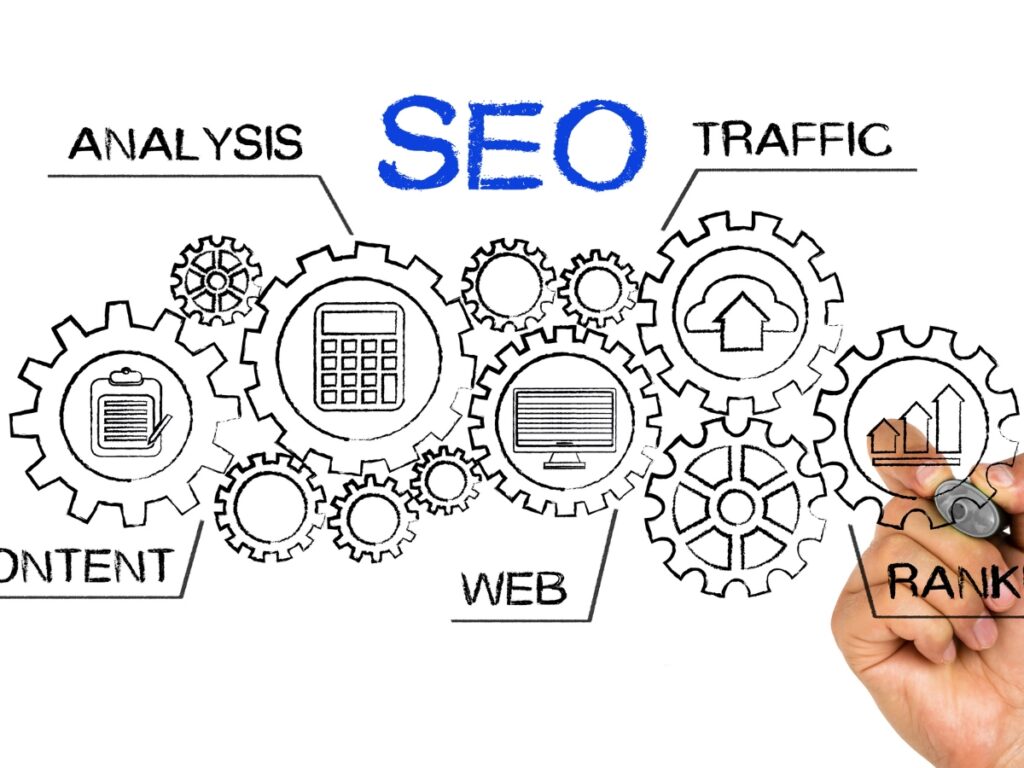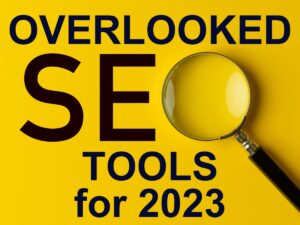Introduction: What Are SEO Organic Traffic Tools and Why Are They Important?
Website SEO organic traffic tools aren’t just about having a unique voice or offering the best products. They also ensure that votes and effects are seen, heard, and optimized.
Welcome to the first article in the Blue Lane Group nine-part series on Overlooked SEO Tools for 2023: Comprehensive Strategies and Innovations for Dominant Digital Performance. This series covers all the essential SEO tools, concepts, and resources to optimize your blog posts and website.
As search engines advance, mastering SEO becomes not just essential but an art form. It’s not only about ranking high but also enhancing user experience. Load times and accessibility are crucial for user retention and reaching a wider audience. SEO matters for both the user and the search engine.
For bloggers and small business owners, SEO offers distinct challenges and opportunities. This series will provide targeted insights to boost your visibility and engagement.

Disclosure: The digital products mentioned in this article are highly regarded in the marketplace and are endorsed by the Blue Lane Group staff. We may earn a commission at no additional cost if you purchase through the provided links.
Table of Contents
The Power of SEO Organic Traffic Tools
Organic traffic, the visitors that land on your website because of unpaid search results, is one of the most valuable forms of website traffic. Unlike paid ads that halt when you stop funding them, organic traffic flows continuously, offering long-term benefits and a higher ROI.
Users often view websites that rank well organically as more credible and authoritative, leading to higher trust and engagement. By leveraging SEO organic traffic tools, businesses can access in-depth analytics and insights, strategically enhancing their organic presence to ensure their content aligns perfectly with what their target audience is searching for.

Key Players in SEO Tool Realm
The digital world teems with SEO tools, each promising to boost a website’s organic presence. However, a few have set themselves apart as indispensable assets for those aiming to dominate organic search.
SEMrush stands tall, offering an all-encompassing suite from keyword research site audits to gap analysis. With its capacity to provide insights into both your and your competitors’ organic keywords, it emerges as a crucial tool for understanding and harnessing SEO organic traffic tool trends.
Ahrefs is another heavyweight, especially praised for its robust backlink analysis prowess. Recognizing that quality backlinks are the backbone of SEO, Ahrefs guides users in identifying, scrutinizing, and mirroring the backlink strategies of top-performing websites, thereby enhancing organic traffic growth.
Moz Pro, on the other hand, seamlessly combines user-centric design with power, presenting tools such as the Link Explorer to reveal potential linking avenues and the Keyword Explorer, curated to spotlight high-traffic, low-competition keywords.
Beyond these industry stalwarts, Google’s Search Console delivers free, firsthand insights directly from the colossus, providing a snapshot of which keywords pull traffic, the indexing landscape, and pivotal site issues that might impede optimal organic performance.
By channeling the capabilities of these premier SEO organic traffic tools, digital strategists and marketers can design tactics that resonate with their desired audience, funneling steady and premium organic traffic to their digital platforms.
Understanding Search Engine Algorithms
Search engine algorithms are intricate systems that retrieve data from their index and deliver the most relevant results for a given query.
These algorithms consider hundreds, if not thousands, of variables when determining a page’s rank. From content relevance, site speed, and mobile optimization to backlinks and user engagement, understanding these factors is pivotal to improving organic reach.
Each algorithm update, like Google’s BERT or Core updates, aims to refine and improve user search results, but it often means that web admins must adapt to ensure their content remains visible.
With insights from SEO organic traffic tools, marketers and web admins can better understand search engine algorithms and harness their complexities to boost organic visibility.

SEO Organic Traffic Tools: search engine algorithms drive data
Features That Set the Best SEO Organic Traffic Tools Apart
Certain standout features in the vast sea of SEO tools separate the best from the rest. The ability to conduct in-depth keyword research with SEO organic traffic tools and provide a clear landscape of high-volume and long-tail keywords is paramount.
Advanced tools like Ahrefs offer this with precision, delivering insights into search volume, keyword difficulty, and even the estimated clicks, ensuring content creators target the most lucrative terms.
Link-building remains a cornerstone of SEO; the best tools provide robust backlink analysis features. This insight is pivotal for reverse-engineering successful link-building campaigns and identifying potential linking opportunities.
Moreover, comprehensive site audits pinpointing technical issues, broken links, duplicate content, or slow-loading pages are necessary. Moz Pro shines in this area, providing actionable recommendations to ensure a site adheres to the best technical SEO practices.
Finally, the evolving nature of search means the best SEO organic traffic tools must offer features that align with current trends, such as voice search optimization and mobile SEO.
Tools like MobileMoxie cater specifically to mobile SEO, emphasizing optimizing for increasing mobile users. As SEO continues to evolve, the tools that continually adapt and integrate these vital features remain indispensable for anyone serious about dominating organic search.

SEO Organic Traffic Tools: it’s all about the features that set you apart from the pack
Benefits of Real-time Traffic Analysis
Real-time traffic analysis is pivotal in the digital age, offering immediate insights into user behavior, site performance, and marketing campaign effectiveness, all of which are vital components of SEO organic traffic tools.
One of the primary benefits is the ability to identify and respond to traffic spikes or drops promptly. Such timely reactions can be essential during promotional campaigns, product launches, or viral content attracting visitors.
Tools like Google Analytics shine here, providing a live overview of site activity, from active users and pages being viewed to geographic locations, allowing web admins to gauge the impact of their strategies immediately.
Another advantage lies in understanding user behavior in real-time, enabling websites to fine-tune user experience instantly. For instance, if a particular landing page receives high traffic but experiences high bounce rates, it signals potential issues with content or design.
Solutions like Hotjar or Crazy Egg visualize where users click, move, and scroll, offering immediate feedback on improving site elements for better engagement and conversions.
Real-time traffic analysis also enhances security. Suspicious traffic patterns, such as a sudden influx from a particular IP address, can indicate DDoS attacks or other malicious activities.
Platforms like Cloudflare help protect against such threats and provide real-time analytics about site traffic, threats blocked, and performance optimizations.
By leveraging the insights from real-time analysis tools, businesses can make swift, data-driven decisions, ensuring optimal site performance, user satisfaction, and enhanced organic growth.

SEO Organic Traffic Tools: immediate insights are crucial for SEO best practices and response
Role of Backlink Analysis Tools
Backlink analysis tools play a crucial role in understanding and bolstering a website’s search engine ranking, acting as an integral component of SEO organic traffic tools. At their core, backlinks serve as endorsements from one website to another, signaling authority, trust, and relevance to search engines.
Using tools like Ahrefs, businesses can delve deep into their backlink profile, identifying which sites link to them, the quality of these links, and the anchor text used. This insight helps ensure a healthy and high-quality backlink profile, which is imperative for SEO success.
Beyond one’s backlinks, these tools empower businesses to study competitors’ backlink strategies. Platforms like SEMrush offer a competitor backlink analysis feature, allowing users to reverse-engineer successful link-building campaigns and discover potential opportunities for their sites.
This competitive insight can unveil valuable link-building strategies, revealing niche-specific websites or blogs open to collaborations or guest post opportunities.
Maintaining a clean backlink profile is essential with the constant evolution of search engine algorithms. Toxic or spammy backlinks can harm a website’s ranking or even result in penalties.
Here, tools like Moz’s Link Explorer come into play, allowing users to identify and disavow potentially harmful links. Businesses can foster a robust and reputable link profile by leveraging backlink analysis tools, propelling their organic reach to new heights.

SEO Organic Traffic Tools: backlinks are one of the primary building blocks of any webpage or blog
Content Optimization for Organic Growth
Content optimization goes beyond keyword inclusion; it encompasses crafting content that resonates with audiences and search engine algorithms to boost organic SEO traffic.
One of the most vital components of content optimization is keyword research. By understanding the terms your audience searches for, you can tailor content to meet those needs. Tools like SEMrush and Ahrefs provide in-depth keyword analysis, revealing search volumes, difficulty ratings, and related terms, ensuring content creators target the most suitable keywords for maximum organic visibility.
However, optimizing content isn’t solely about the written word. Ensuring content is structured appropriately, mobile-friendly, and offers an excellent user experience is equally crucial. Yoast SEO, a popular WordPress plugin, aids in this process, providing real-time feedback on content readability, keyword density, and meta descriptions, guiding users toward creating SEO-friendly content.
Moreover, tools like Clearscope and Frase.io assist content creators by analyzing top-ranking content for specific keywords, offering insights and recommendations to enhance content relevance and depth, and aligning it better with user intent.
Beyond this, engaging visuals, videos, and infographics can boost content appeal, leading to higher user engagement and more extended site visits. Platforms like Canva or Venngage offer easy-to-use tools to create compelling visuals that can supplement and elevate the content.
When content is both valuable to the user and optimized for search engines, it becomes a potent tool for driving consistent organic growth and strengthening brand authority.

SEO Organic Traffic Tools: quality content is a crucial pillar of all successful websites
Importance of Mobile SEO Tools
In today’s digital landscape, the rise of smartphones has fundamentally transformed how users approach organic search results. Mobile search, having now surpassed desktop, underscores that mobile SEO is not just a bonus but a critical necessity for businesses aiming to connect with a broad audience.
A mobile-optimized website is paramount, ensuring users experience effortless access and navigation on their devices. This leads to an enhanced user experience, diminishing bounce rates, and bolstering conversions. The significance of mobile is further highlighted by Google’s mobile-first indexing strategy, emphasizing the mobile version of a site for ranking determinations.
Instruments such as Google’s Mobile-Friendly Test furnish instant evaluations of a website’s mobile readiness, pinpointing areas needing enhancement.
Moreover, performance is an essential facet of mobile SEO. Since mobile users often possess fleeting attention and minimal tolerance for sluggish pages, websites must be both speedy and fluid on mobile platforms.
Tools like Google’s PageSpeed Insights and GTmetrix stand out in this domain, bestowing crucial insights on site performance and offering tailored recommendations for mobile-centric optimization.
It’s also worth noting that local searches are predominantly executed via mobile. Users frequently seek services or establishments “near me” while moving. Utilizing specialized tools allows businesses to fine-tune their local SEO, positioning themselves prominently in pertinent local searches and engaging potential clients precisely when conversion likelihood is at its zenith.
In this mobile-centric era, capitalizing on the potential of mobile SEO tools becomes a linchpin for businesses striving for pronounced visibility and competitiveness in organic search outcomes.

SEO Organic Traffic Tools: SEO and optimized mobile engagement strategies are more critical now than ever
Local SEO vs. Global SEO Tools
Local and Global SEO caters to unique audience segments, necessitating distinct methodologies and tools for optimal organic search results impact. Local SEO zeroes in on refining a website to emerge prominently in local search outcomes, which is instrumental for physical establishments or entities serving specific locales.
Instruments like Moz Local and BrightLocal are leaders in this niche, empowering enterprises to streamline online listings, oversee reviews, and conduct local competitor analysis. With the uptick in “near me” search queries, a fortified local SEO approach, bolstered by adept tools, can notably escalate physical store footfalls and regional conversions.
Conversely, Global SEO orchestrates strategies aiming at a cosmopolitan audience. For entities distributing goods or services globally, fine-tuning content to resonate with diverse linguistic nuances, cultural contexts, and search patterns is crucial.
SEMrush, boasting a comprehensive database, furnishes insights into international search dynamics, enabling professionals to mold content and initiatives befitting various global sectors.
Furthermore, utilities like Hreflang Tags Generator are invaluable in ascertaining that search platforms present the apt language or regional-based URL in search findings, aligning content with the searcher’s geographical and linguistic backdrop.
Tracking Competitor Strategies
In the ever-evolving world of SEO organic traffic tools, keeping a tab on one’s strategy is essential, as is understanding what your competitors are doing. By tracking and analyzing competitor SEO strategies, businesses can identify gaps in their approach, discover new opportunities, and refine their tactics to stay ahead.
One of the most potent tools in this arena is SEMrush, which provides comprehensive data on competitors’ organic keywords, backlink profiles, and ad strategies. By understanding which keywords competitors rank for and which they invest in, businesses can identify potential areas for expansion or improvement in their keyword targeting.
Another invaluable tool for competitor analysis is Ahrefs. With its expansive link database, Ahrefs allows users to explore the backlink profile of any website, offering insights into where competitors are getting their links and which content is attracting the most attention.
This can be instrumental in shaping a robust link-building strategy, targeting high-quality sites, and creating content that resonates with the audience and attracts backlinks.
Beyond backlinks and keywords, understanding competitors’ content strategies can offer a competitive edge. Tools like BuzzSumo Excel are here. Users can see which content pieces get the most shares and engagement across social media platforms by entering a competitor’s URL.
This can inform a business’s content strategy, highlighting popular topics, formats, or promotional methods worth exploring. By continuously tracking and learning from competitors, companies can adapt, innovate, and ensure their SEO strategies remain effective and ahead of the curve.

SEO Organic Traffic Tools: always keep at least one eye on the competition and give your users what they want
The Future of SEO Tools
As the digital landscape evolves, SEO tools must adapt to keep up with changing search engine algorithms, user behaviors, and technological advancements.
AI and machine learning are beginning to play a significant role in SEO, driving more sophisticated tools that can better predict search trends, optimize content in real-time, and offer deeper insights into user intent.
Clearscope, for instance, employs AI to analyze top-ranking content and provide actionable recommendations to content creators, ensuring their material aligns with current standards and best practices.
Voice search and visual search are other emerging trends reshaping the search landscape. As more people turn to voice-activated assistants like Alexa or Google Assistant for search queries, SEO tools must adapt to understand and optimize for this new paradigm.
Tools like SEMrush already incorporate features to track and analyze voice search data, helping businesses refine their content strategy to cater to these users. Similarly, as platforms like Pinterest enhance their visual search capabilities, tools that can analyze visual content and offer optimization recommendations will become crucial.
Integrating SEO tools with other digital marketing platforms is also on the horizon. As businesses strive for a holistic approach to online marketing, the ability for SEO tools to seamlessly integrate with CRM systems, email marketing platforms, or social media management tools will be invaluable.
This interconnected ecosystem will allow for more comprehensive insights and more streamlined optimization processes, ensuring businesses can effectively leverage SEO with other marketing strategies. Embracing these future-forward tools and staying abreast of emerging trends will be essential for companies looking to maintain a robust online presence.

SEO Organic Traffic Tools: the importance of SEO in websites will only get more relevant with time
In Closing: Embracing the Future of Organic Traffic and SEO
Understanding and mastering SEO organic traffic tools is akin to navigating a vast digital ecosystem with evolving tactics and cutting-edge tools.
Throughout our exploration, one thing remains clear: the significance of organic traffic as a cornerstone for online success. It’s the lifeblood of digital visibility, and in conjunction with SEO, it becomes a potent tool for businesses looking to establish a dominant online presence.
With the myriad of tools and strategies available today, selecting those that align with current trends yet are adaptable to future shifts is crucial. Organic traffic, enriched by potent SEO strategies, brings genuine users to your digital doorstep, users who are actively seeking the solutions you offer.
The realm of SEO tools, from backlink analysis to real-time traffic assessments, provides a comprehensive lens to view and optimize this invaluable stream of organic visitors.
As we look ahead, emerging technologies, whether AI-driven SEO tools or the rise of voice and visual searches, signify that our approach to harnessing organic traffic must be fluid and innovative.
To sum it up, the future beckons with promises of greater digital exploration and opportunities. Organic traffic, paired with the right SEO strategies and tools, is the compass that can guide businesses through this vast digital terrain.
Embracing these tools and strategies is not just a choice but a necessity for those aiming to lead in the digital age.
You Might Also Like:
If you enjoyed this article and received value from it, check out the other Blue Lane Group articles in the Overlooked SEO Tools for 2023: Comprehensive Strategies and Innovations for Dominant Digital Performance series:
- Unlocking Growth: Essential SEO Organic Traffic Tools for 2023
- Elevate Your Online Presence: Discover the Best SEO Link Building Tools of 2023
- Empowered Entrepreneurs: Top Local SEO Tools for Small Businesses in 2023
- Inspiring Content: Essential SEO Tools for Bloggers in 2023
- Powering Your Platform: Best SEO Plugins for WordPress in 2023
- Revolutionize Your Analysis: Top AI Keyword Research Tools for 2023
- Proven Success: Optimal SEO Tools for Loading Speed in 2023
- Mastering Metrics: Best Google Analytics SEO Tools for 2023
- Rise to the Top: Proven SEO Strategies for Google Ranking in 2023





